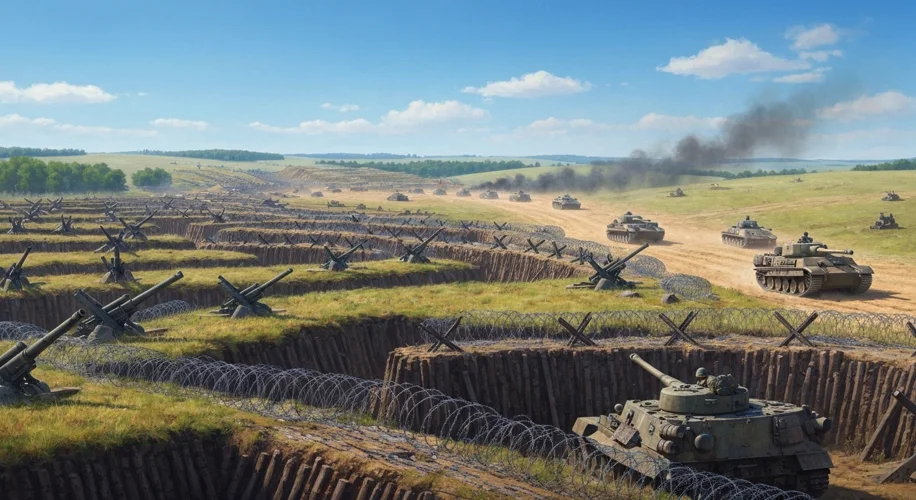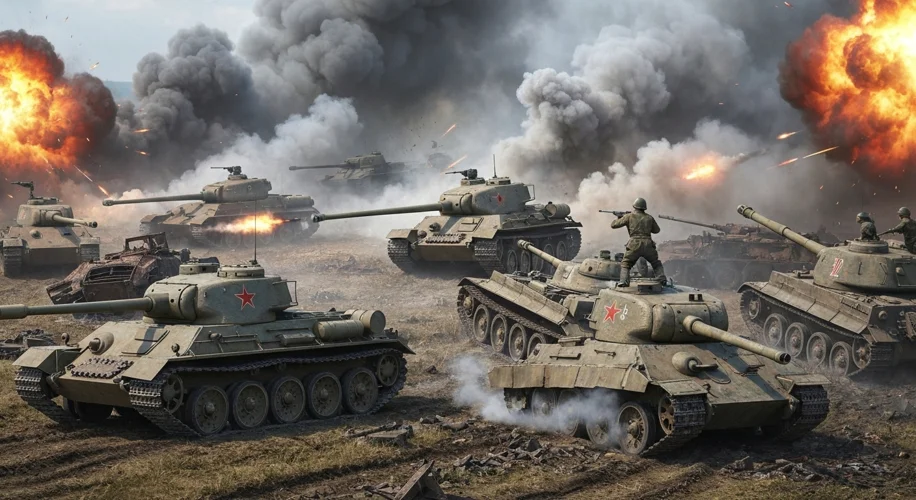The summer of 1943 on the Eastern Front was a period of agonizing tension. After the grinding defeat at Stalingrad, the German war machine, though battered, was preparing for one final, massive offensive. Codenamed “Operation Citadel,” the target was the Kursk salient, a vast bulge in the Soviet lines that represented a strategic opportunity for the Germans to encircle and destroy significant Red Army forces. For the Soviets, however, this salient was also an invitation, a carefully laid trap.
The Battle of Kursk, fought from July 5th to August 23rd, 1943, would become the largest tank battle in history and a decisive turning point in World War II. But the sheer scale of the bloodshed, particularly the lopsided casualty figures, tells a story of technological disparities, strategic gambits, and the brutal human cost of industrial-scale warfare.
The Strategic Chessboard
Following the harrowing winter and spring campaigns, both sides were exhausted but resolute. German High Command, under Adolf Hitler, saw Kursk as their last chance to regain the initiative on the Eastern Front. The plan was a classic pincer movement: Army Group South, striking from the south, and Army Group Center, attacking from the north, would meet behind Soviet lines, crushing the salient. The Germans concentrated their best armored divisions, including the formidable Tiger and Panther tanks, and the feared Ferdinand (Elefant) tank destroyers.
However, the Soviets, under the brilliant strategists Georgi Zhukov and Aleksandr Vasilevsky, had anticipated “Citadel.” For months, they had been building an elaborate, multi-layered defensive system around Kursk. This “deep battle” strategy involved multiple defensive belts, mined fields, anti-tank ditches, and countless concealed firing positions for artillery and anti-tank guns. Their goal was not to meet the Germans head-on in the initial assault, but to absorb the initial shock, bleed the enemy forces, and then launch devastating counteroffensives.

The Clash of Titans
The battle opened with a massive German assault. The northern pincer, led by General Hoth’s 2nd Panzer Army, and the southern pincer, commanded by Field Marshal von Manstein’s Army Group South, hurled their armored might against the Soviet defenses. The initial German advance was brutal, met with fierce resistance and a hail of fire from concealed Soviet positions.
The northern sector saw heavy fighting, but the German advance stalled against the well-prepared Soviet defenses. In the south, however, the fighting was even more intense. The village of Prokhorovka became the epicenter of what is arguably the most famous engagement within the larger battle: a colossal clash of Soviet T-34 tanks and German Panzer IVs, Tigers, and Panthers. Accounts from the time describe a scene of apocalyptic chaos, with hundreds of tanks locked in a desperate melee, exploding, burning, and churning the earth.
While initial German estimates suggested a swift victory, the reality was a grinding, attritional battle. The Soviet defenders, though suffering immense casualties, held their ground, their sheer numbers and resilient fortifications gradually blunting the German spearheads. The German tanks, while technologically superior in many respects, were vulnerable to Soviet tactics, particularly their effective anti-tank guns and the sheer number of T-34s that could swarm an enemy position.
The Unbalanced Scale of Loss
The casualty figures from Kursk are staggering, with estimates varying but consistently showing Soviet losses significantly higher than German ones. The Soviets are estimated to have lost over 1.7 million men and thousands of tanks, artillery pieces, and aircraft. German losses, while substantial, were around 400,000 to 500,000 men and fewer armored vehicles. This lopsided ratio, particularly in terms of materiel, has led to much analysis.
Several factors contributed to this imbalance. The Soviets, fighting on their own territory and with a vast pool of manpower, were willing to accept higher losses to achieve their strategic objectives. Their “deep battle” doctrine, designed to wear down the attacker, was highly effective, but it came at a terrible cost. The introduction of new Soviet weaponry, like the SU-152 assault gun, also played a role in countering German armor.
Furthermore, the German offensive was hampered by a lack of surprise, intelligence failures, and logistical constraints. Hitler’s hesitation in launching “Citadel” allowed the Soviets ample time to prepare. Once the battle began, German armor was often forced to fight in concentrated pockets, making them easier targets for Soviet artillery and air attacks.
The Turning Tide
The German offensive ultimately failed to achieve its objectives. By mid-July, the German forces were exhausted and unable to break through the Soviet defenses. More critically, the Allied invasion of Sicily on July 10th, 1943, forced Hitler to divert crucial troops and resources from the Eastern Front to Italy. This decision, coupled with the inability to achieve a decisive victory at Kursk, proved fatal for “Operation Citadel.”
With the German offensive blunted, the Red Army seized the initiative. The Soviets launched their own massive counteroffensives, codenamed “Operation Kutuzov” and “Operation Rumyantsev,” pushing the Germans back and liberating Orel and Belgorod. The strategic initiative on the Eastern Front had definitively shifted to the Soviet Union.
The Battle of Kursk marked the beginning of the end for Nazi Germany on the Eastern Front. It was a brutal, costly victory for the Soviets, a testament to their resilience, strategic brilliance, and the immense human sacrifice required to turn the tide of the war. The echoes of those seventy-five days of relentless combat, the roar of engines, the thunder of artillery, and the cries of men would forever reverberate as the sound of a world changing course.

